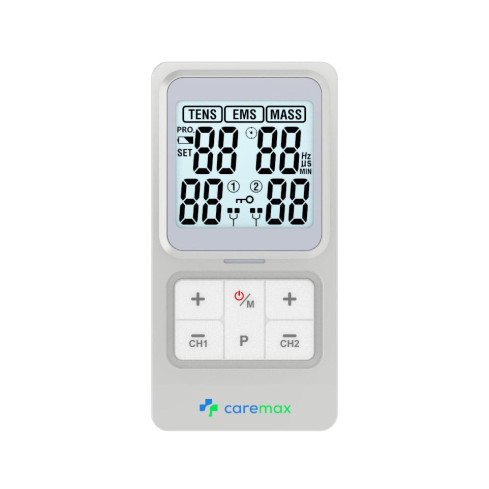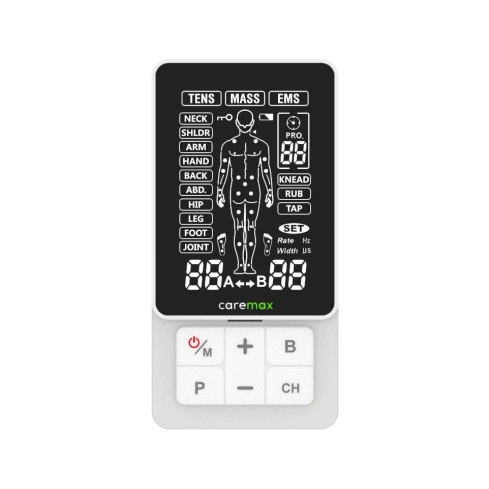Product added to cart
- Home
- TENS & EMS
- TENS machines and period pain relief: A complete guide
TENS machines and period pain relief: A complete guide
Menstrual and period pain describes lower abdominal and lower back pain that occurs before and during a women's period. According to the Royal College of General Practitioners, around 70-90% of females between 16-25 experience painful menstruations.
Period pains can become disabling and affect your livelihood - including work, personal and social life. While certain medications help treat period cramps, they can lead to frequent and even severe symptoms.
Caremax's mission is to provide safe, effective and non-medicated approaches for period pain relief. TENS machines are portable devices that have been used for the past 50 years. It uses electric current to help ease discomfort, even for those with period pain. This article will go through the science behind TENS machines and how they can help reduce your menstrual cycle discomfort.
On the other hand, if you are simply after a tens machine designed for period pain relief, please explore our Jumper Smart Bluetooth Wireless Period Pain TENS. Its uniquely designed shapes can be used to provide maximum relief from period cramps.
What is a TENS machine?
A transcutaneous electrical nerve stimulation (TENS) machine is a portable device that can be used to ease short-term and chronic pain. Unlike other more aggressive forms of treatment, a TENS machine is non-invasive and drug-free. Instead, the machine's gel pads deliver electricity to stimulate the nerves around the treatment area. As a result, it has very few and uncommon side–effects [1].
As a result, TENS machines are safe and effective ways to help relieve pain from multiple areas and conditions. One way to use a TENS machine is to help treat menstrual pain or dysmenorrhea (severe and frequent cramps). This article will highlight how TENS machines can be used to treat these pains and aches.
Click here to learn more about TENS machines.
What is menstrual pain?
Menstrual pain or period pain describes discomfort and cramping felt in the lower abdomen. It typically occurs before and/or during a woman's period.
The Process
At the start of the period, the lining of the uterus (known as the endometrium) begins to shed. This process causes bleeding at the end of the menstrual cycle and prepares the egg for the next chance to become fertilised. To learn more about menstrual cycles and periods, please visit The Royal Women's Hospital website.
Contractions of the uterine muscles in the abdomen help remove the shed lining. A hormone called prostaglandin causes these contractions and cramping [2]. This is the key contributing factor to menstrual pain.
Dysmenorrhea
For some women, their cramps can become frequent and particularly painful during their period. This is known as dysmenorrhea, and it is split up into primary and secondary categories. The cause of dysmenorrhea is complex and not yet fully understood.
One potential reason for primary dysmenorrhea is increased levels of prostaglandin [3]. More significant contractions and cramping of the uterus (from higher prostaglandin) lead to more pain.
Secondary dysmenorrhea describes menstrual pain caused by abnormal changes inside or outside the uterus. Urinary tract infections, endometriosis and irritable bowel syndrome, are just examples of some conditions that may lead to secondary dysmenorrhea [3].
How can a TENS Machine help with period pain relief?
TENS machines have proven to reduce pain in various settings, such as knee osteoarthritis [4] and during labour [5]. Using a TENS machine for period pain is no exception.
A TENS machine can help ease pain during a woman's period by blocking nerve signals from the lower abdominal area. Research has also suggested that this can lead to the release of your body's natural pain relieving chemicals (opioids) and the reduction of prostaglandins.
Multiple studies [1][2] have shown that TENS machines significantly reduce pain and improve women's quality of life during their period. It provides women with a safer and non-drug option against medications (e.g. nonsteroidal anti-inflammatory drugs, oral contraceptives, etc.) that have more frequent side effects.
Access to quick, temporary and safe period of pain relief should be a game changer for all Australian women.
Different TENS modes for treatments
There are 3 TENS modes should be considered when selecting a treatment for period cramps relief - the pulse width, intensity and frequency. These are all settings that can be changed when using a TENS machine.
Pulse width describes the duration of each sensation from the machine. On the other hand, frequency measures how quickly the treatment is being delivered. Finally, the intensity is adjustable throughout the therapy and shows how strong the treatment feels.
For period pain, it seems that high-frequency treatment >50Hz (mainly around 100Hz) appears to be the most effective [1][2]. Pulse width and intensity seem to be less critical but adjusted to the user's preference. However, most researchers kept the pulse width around 100-200μsec (microseconds) and intensity to a comfortable level. While low frequency can be effective, high frequency is generally the superior of the two options for pain relief [1].
Are TENS units safe for menstrual cramps?
When used correctly, TENS machines are generally very safe for menstrual cramps. Typically, the most common symptoms are related to skin reactions to the gel pads. Please read our complete TENS machine guide to ensure that you're using the device appropriately and when not to use it.
However, between 7%-12.5% of women [1] have reported more specific side effects, such as:
- Temporary headaches
- Skin reactions
- Increased menstrual flow
Compared to medications, such as oral contraceptives, these side effects are less common and nowhere near as dangerous.
Where do you put TENS Machine pads for period pain?
Always consult a doctor or healthcare professional about appropriate TENS machine use and placement. Try to avoid placing the pads near key areas, such as the chest, neck and certain parts of the abdomen. Additionally, only place electrodes over areas that you can feel and have no lack of sensation.
Research indicates that TENS machine pads should be placed around the painful area and dermatomal pain distributions (the nerves that cause the pain sensations) [1][]. As a result, we recommend placing your pads following the image below. Ensure that these pads are at least 1 inch (2.5cm) away from each other. However, optimal placement may vary person-to-person.
Using Caremax TENS machine for Period Pain Mangement
We provide a comprehensive packaging solution for Period Pain Relief. Discover the most sought-after products below essential for effective TENS therapy treatment.
 |
 |
| Caremax 2.0 Classic TENS machine | Caremax 2.0 Pro TENS Machine |
References
- Elboim-Gabyzon, M., & Kalichman, L. (2020). Transcutaneous Electrical Nerve Stimulation (TENS) for Primary Dysmenorrhea: An Overview. International journal of women's health, 12, 1–10. https://doi.org/10.2147/IJWH.S220523
- Barcikowska, Z., Rajkowska-Labon, E., Grzybowska, M. E., Hansdorfer-Korzon, R., & Zorena, K. (2020). Inflammatory Markers in Dysmenorrhea and Therapeutic Options. International journal of environmental research and public health, 17(4), 1191. https://doi.org/10.3390/ijerph17041191
- Nagy H, Khan MAB. Dysmenorrhea. [Updated 2021 Sep 1]. In: StatPearls [Internet]. Treasure Island (FL): StatPearls Publishing; 2022 Jan-. Available from: https://www.ncbi.nlm.nih.gov/books/NBK560834/
- Osiri, M., Welch, V., Brosseau, L., Shea, B., McGowan, J. L., Tugwell, P., & Wells, G. A. (2000). Transcutaneous electrical nerve stimulation for knee osteoarthritis. Cochrane Database of Systematic Reviews, (4).
- Santana, L. S., Gallo, R. B. S., Ferreira, C. H. J., Duarte, G., Quintana, S. M., & Marcolin, A. C. (2016). Transcutaneous electrical nerve stimulation (TENS) reduces pain and postpones the need for pharmacological analgesia during labour: a randomised trial. Journal of physiotherapy, 62(1), 29-34.
Categories
- TENS & EMS (18)
- Latest News (41)
- Massager (2)
- Nebuliser (8)
- Skin Care (3)
- Period Pain Management (1)
- Fitness (2)

